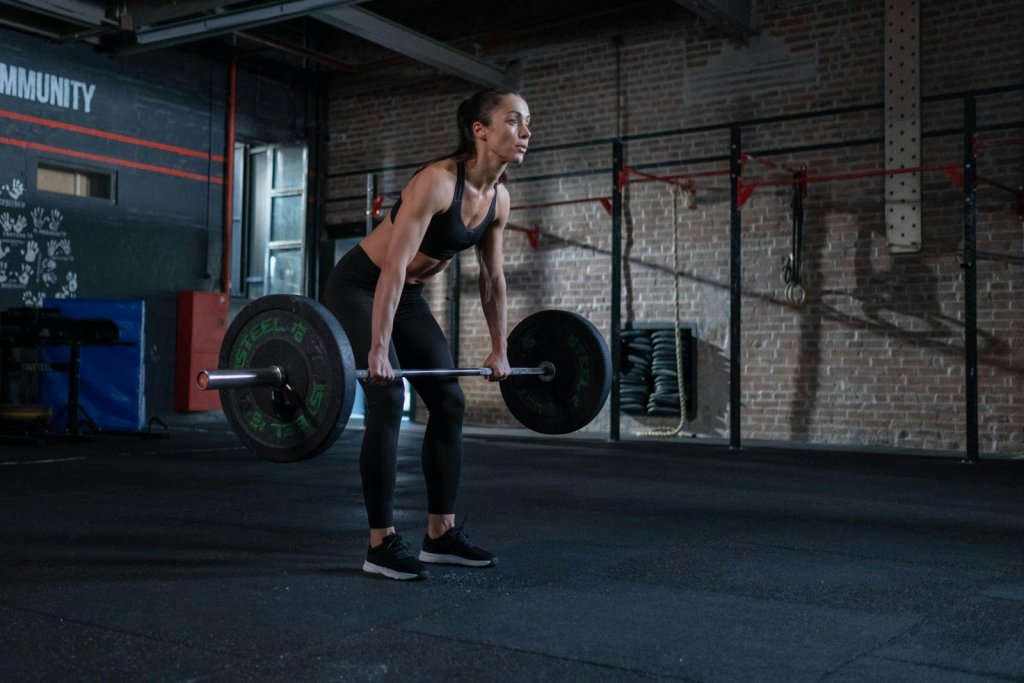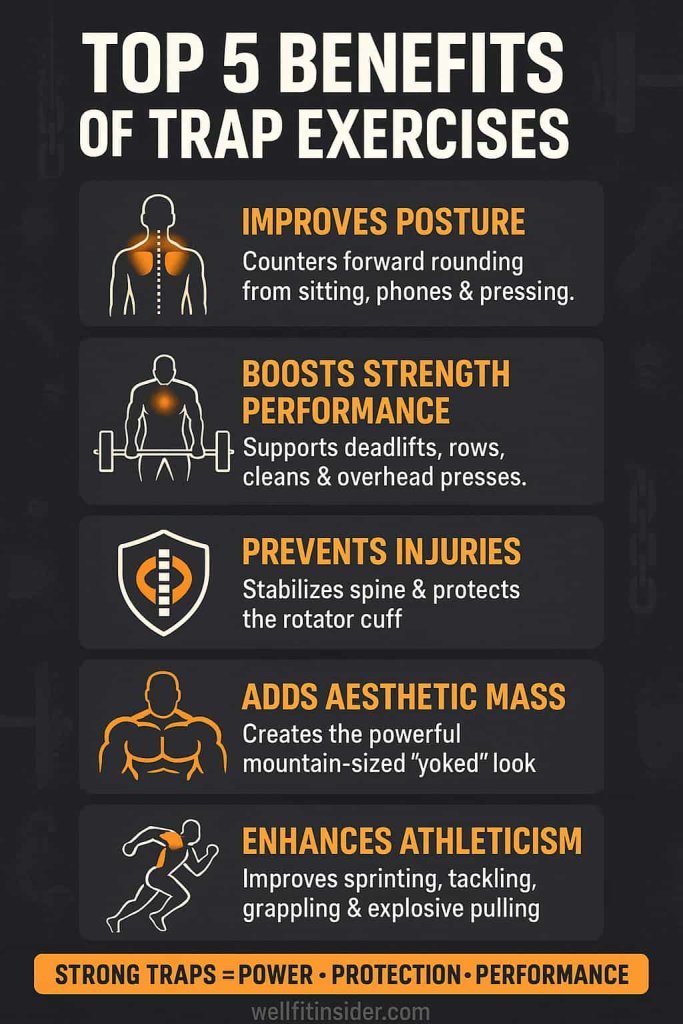Yes, trap exercises are the most effective way to build massive, mountain-sized traps. The trapezius muscles sit across the upper back and neck, giving lifters that powerful “yoked” look. But beyond aesthetics, strong traps stabilize your shoulders, improve posture, protect your spine, and boost performance in nearly every pulling and pressing lift.

Understanding how to train traps correctly is crucial. Many lifters only perform shrugs, but the traps are a three-part muscle (upper, middle, and lower) that respond to a variety of movements—from heavy deadlifts to carries and face pulls. In this guide, you’ll find the 12 best trap exercises, complete with benefits, step-by-step instructions, and trainer tips to help you build dense, powerful traps.
Benefits of Trap Exercises
Training traps does more than just make your neck and shoulders look bigger. Here’s why you should focus on them:

- Improves posture → counters the forward rounding caused by sitting, phones, and pressing.
- Boosts strength performance → strong traps support deadlifts, rows, cleans, and overhead presses.
- Prevents injuries → traps stabilize the spine and protect the rotator cuff.
- Adds aesthetic mass → creates the “mountain-sized” yoked look admired in bodybuilding.
- Enhances athleticism → helps in sprinting, tackling, grappling, and any sport requiring explosive pulling.
📌 According to Experts, exercises like farmer’s carries and trap bar deadlifts not only build traps but also strengthen grip and core, enhancing athletic power across sports.
12 Best Trap Exercises (Step-by-Step)
The trapezius (traps) are a major muscle group that run from your neck to your mid-back, playing a key role in posture, pulling strength, and shoulder stability. Building strong traps not only improves your physique with a thicker upper body but also supports athletic power and injury prevention. Below are the 12 best trap exercises, explained step by step.
1. Barbell Shrug
Why it works: The gold standard for directly isolating and building the upper traps.
How to do it:
- Hold a barbell at your thighs with an overhand grip.
- Stand tall with chest up and arms straight.
- Shrug your shoulders as high as possible toward your ears.
- Pause for 1–2 seconds at the top.
- Lower slowly under control.
Muscles worked: Upper traps.
Trainer Tip: Use lifting straps if grip fails before your traps fatigue. Keep the movement vertical—avoid rolling your shoulders.
2. Dumbbell Shrug
Why it works: A versatile variation that allows a greater range of motion than the barbell.
How to do it:
- Hold a dumbbell in each hand at your sides.
- Keep palms facing your body.
- Shrug upward as high as you can.
- Pause, then lower slowly.
Muscles worked: Upper traps.
Trainer Tip: Lean slightly forward to increase trap activation. Don’t rush—use controlled reps.
3. Trap Bar Deadlift
Why it works: A total-body lift that heavily recruits traps for posture and stability.
A 2020 Journal of Strength & Conditioning Research study confirmed trap bar deadlifts activate traps more than conventional deadlifts.
How to do it:
- Step inside a trap (hex) bar and grip the handles.
- Brace your core, sit back slightly, and drive through your legs.
- Stand tall, locking hips and knees.
- Lower under control.
Muscles worked: Traps, glutes, hamstrings, quads, core.
Trainer Tip: Keep lats tight to protect your lower back.
4. Rack Pull
Why it works: A partial deadlift from knee or mid-shin height, emphasizing trap overload.
How to do it:
- Place a barbell on safety pins in a power rack.
- Grip the bar just outside your thighs.
- Pull the bar to full lockout, engaging traps and shoulders.
- Lower slowly to pins.
Muscles worked: Upper traps, erectors, glutes.
Trainer Tip: Load heavier than a normal deadlift for strength carryover.
5. Farmer’s Carry
Why it works: Builds functional trap strength and endurance while training grip and posture.
How to do it:
- Pick up heavy dumbbells or farmer’s carry handles.
- Stand tall with shoulders back and core braced.
- Walk forward for 30–60 seconds.
Muscles worked: Upper traps, forearms, core.
Trainer Tip: Use heavy loads but maintain tall posture. Avoid leaning side-to-side.
6. Upright Row
Why it works: Trains traps and delts with a vertical pulling motion.
How to do it:
- Hold a barbell or dumbbells with a shoulder-width grip.
- Pull vertically to chest height, leading with elbows.
- Pause, then lower slowly.
Muscles worked: Traps, delts, biceps.
Trainer Tip: Use a wider grip to reduce shoulder impingement risk. Stick with moderate weights.
7. Face Pull
Why it works: Strengthens mid-traps and rear delts, improving posture and shoulder stability.
How to do it:
- Attach a rope to a high pulley.
- Grip both ends and pull toward your forehead.
- Flare elbows outward.
- Squeeze shoulder blades together at the end.
Muscles worked: Mid-traps, rear delts, rhomboids.
Trainer Tip: Focus on squeezing, not just pulling—quality over weight.
8. Barbell Bent-Over Row
Why it works: A compound pulling movement that builds back thickness and mid-traps.
How to do it:
- Grip a barbell with hands just outside shoulder-width.
- Bend forward at the hips until torso is at ~45°.
- Row barbell toward chest.
- Lower under control.
Muscles worked: Traps, rhomboids, lats, erectors.
Trainer Tip: Keep your core tight and avoid jerking the bar.
9. Power Clean
Why it works: An Olympic lift that develops explosive power and trap growth through the shrug phase.
How to do it:
- Start with a barbell on the floor like a deadlift.
- Explosively extend hips and knees while shrugging hard.
- Catch the bar on shoulders in a quarter-squat.
- Stand tall.
Muscles worked: Traps, delts, glutes, hamstrings, quads.
Trainer Tip: Learn under a coach or supervision—technical but highly effective.
10. Overhead Barbell Press
Why it works: Strengthens traps as stabilizers during overhead work.
How to do it:
- Grip barbell at shoulder height.
- Press straight overhead until arms lock out.
- Lower slowly to start.
Muscles worked: Traps, delts, triceps, core.
Trainer Tip: Keep ribs down and avoid leaning back to protect the spine.
11. Incline Dumbbell Row
Why it works: A strict row variation that isolates mid-traps and rhomboids.
How to do it:
- Lay chest-down on an incline bench.
- Hold dumbbells with neutral grip.
- Row dumbbells toward ribs.
- Squeeze shoulder blades at top.
Muscles worked: Mid-traps, rhomboids, lats.
Trainer Tip: Don’t overload—focus on controlled reps and scapular retraction.
12. Y-Raise (Cable or Dumbbell)
Why it works: A corrective exercise that isolates upper and mid-traps for posture.
How to do it:
- Hold light dumbbells or cables.
- Raise arms overhead in a “Y” shape.
- Pause briefly, then lower under control.
Muscles worked: Upper traps, lower traps, delts.
Trainer Tip: Use very light weights—technique matters more than load.
Common Mistakes to Avoid
- Rolling shoulders during shrugs.
- Using momentum instead of strict control.
- Only training upper traps while neglecting mid/lower traps.
- Overloading with poor form.
- Ignoring posture—slouching cancels out trap benefits.
How to Program Trap Training
- Beginners: 1–2 trap sessions per week.
- Intermediate/Advanced: 2–3 times per week, combining heavy compounds (deadlifts, carries) with isolation (shrugs, face pulls).
- Volume: 8–16 total sets weekly is ideal for growth.
FAQs About Trap Training
1. What exercise builds traps fastest?
Barbell shrugs and trap bar deadlifts due to heavy load capacity.
2. Do deadlifts build traps?
Yes—conventional and trap bar deadlifts are top compound trap-builders.
3. How long until I see trap growth?
With consistent training, noticeable growth usually happens within 8–12 weeks.
4. Are upright rows safe?
Yes, if done with moderate weight and proper grip width.
5. Can I train traps every day?
Not recommended—2–3 times per week allows recovery and growth.
6. Do I need machines for traps?
No. Free weights and bodyweight are enough, though machines can add variety.
7. Will stronger traps improve posture?
Yes. Well-developed traps pull shoulders back, correcting slouching.
Conclusion
Trap exercises are essential for strength, posture, and aesthetics. From heavy deadlifts and carries to shrugs and face pulls, the best results come from combining compound and isolation movements.
👉 If your goal is mountain-sized traps, add 2–3 of these exercises to your weekly workouts, progressively increase weight, and stay consistent. Your traps will grow thicker, stronger, and more powerful.
